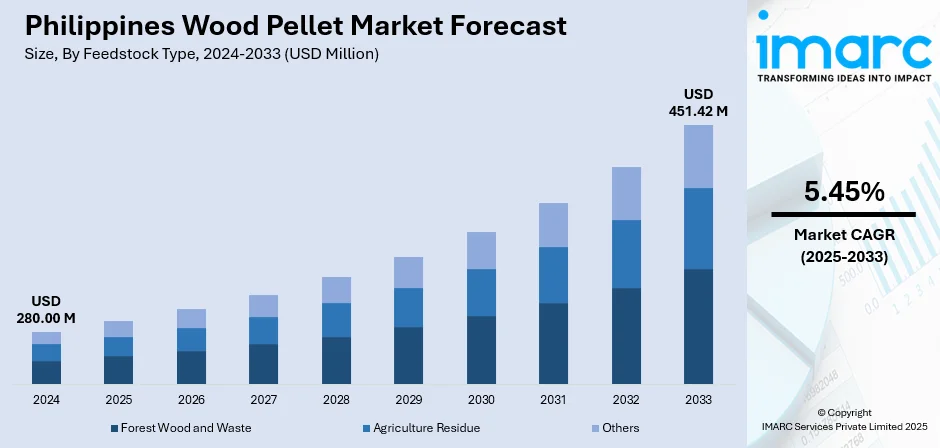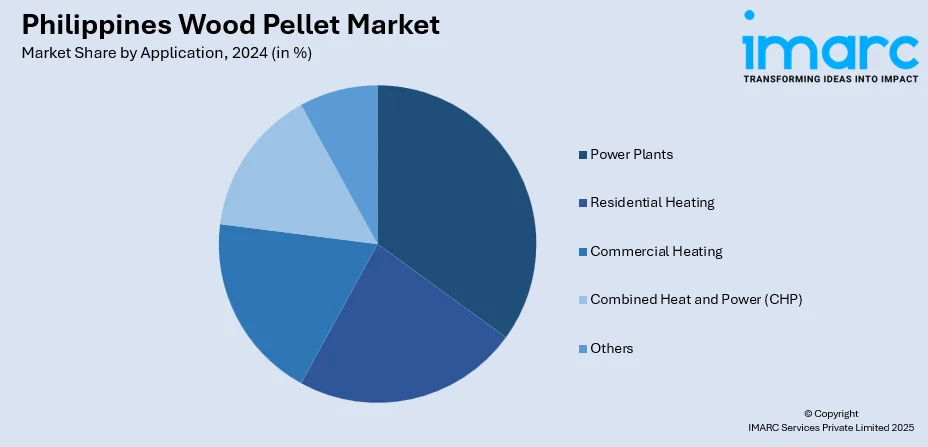
Philippines Wood Pellet Market Size, Share, Trends and Forecast by Feedstock Type, Application, and Region, 2025-2033
Philippines Wood Pellet Market Overview:
The Philippines wood pellet market size reached USD 280.00 Million in 2024. Looking forward, the market is projected to reach USD 451.42 Million by 2033, exhibiting a growth rate (CAGR) of 5.45% during 2025-2033. The market is expanding steadily, driven by increasing demand for renewable energy sources and sustainable fuel alternatives. Growing awareness about environmental issues and the necessity to decrease dependence on conventional fossil fuels are fueling the adoption of wood pellets in both residential and industrial arenas. Supportive government initiatives and technological advancements in biomass energy production are further enhancing market opportunities, contributing to the growth of the Philippines wood pellet market share.
|
Report Attribute
|
Key Statistics
|
|---|---|
|
Base Year
|
2024
|
|
Forecast Years
|
2025-2033
|
|
Historical Years
|
2019-2024
|
| Market Size in 2024 | USD 280.00 Million |
| Market Forecast in 2033 | USD 451.42 Million |
| Market Growth Rate 2025-2033 | 5.45% |
Philippines Wood Pellet Market Trends:
Industrial Demand Growth
The industrial sector in the Philippines is seeing a steady rise in the use of wood pellets, recognized for being a sustainable and economical substitute for traditional fuels. Manufacturing facilities and power generation plants are increasingly adopting biomass energy options to lessen their dependence on fossil fuels and reduce operational expenses. Wood pellets offer a steady energy supply and are simpler to store and transport than other forms of biomass. Their adaptability makes them ideal for use in boilers, heating systems, and co-firing applications in power plants. With a growing focus on minimizing carbon footprints, many industries are incorporating wood pellets into their sustainability plans. This growing trend aligns with environmental objectives and fosters a dependable domestic market for producers, positioning industrial usage as one of the key factors driving long-term stability and growth in the Philippines' wood pellet market.

To get more information on this market, Request Sample
Export Potential
The wood pellet sector in the Philippines is increasingly tapping into opportunities from global demand, especially from nations committed to renewable energy. There is a strong demand for wood pellets in markets like Europe and certain parts of Asia, where biomass plays a pivotal role in clean energy initiatives. With abundant forestry resources, the Philippines could emerge as a dependable supplier within this international value chain. By emphasizing quality assurance and sustainable sourcing, local manufacturers can improve their competitiveness in the export arena. Strengthening trade relationships and capitalizing on governmental support for renewable energy exports could further unveil opportunities for growth. These prospects provide additional sources of income and boost Philippines wood pellet market growth, as international buyers increasingly look to the country as a viable source of ecological fuel.
Technological Advancements
Innovation in technology is essential for enhancing both the efficiency and quality of wood pellet production in the Philippines. Modern pelletizing machinery and drying systems allow producers to achieve greater output while maintaining consistent quality, thus minimizing waste and reducing production expenses. Advances in biomass processing also facilitate better usage of raw materials such as wood residues, sawdust, and agricultural byproducts. Such improvements are making wood pellets a more competitive option against traditional energy sources in both domestic and overseas markets. Furthermore, technological advancements ensure adherence to global quality regulations, which is crucial for gaining access to export markets. The implementation of automation and digital oversight allows manufacturers to optimize energy consumption and streamline their operations, further boosting productivity. Overall, ongoing technological progress is enhancing the efficiency, reliability, and market desirability of wood pellets in the Philippines, thereby supporting sustained growth within the industry.
Philippines Wood Pellet Market Segmentation:
IMARC Group provides an analysis of the key trends in each segment of the market, along with forecasts at the country and regional levels for 2025-2033. Our report has categorized the market based on feedstock type and application.
Feedstock Type Insights:
- Forest Wood and Waste
- Agriculture Residue
- Others
The report has provided a detailed breakup and analysis of the market based on the feedstock type. This includes forest wood and waste, agriculture residue, and others.
Application Insights:

- Power Plants
- Residential Heating
- Commercial Heating
- Combined Heat and Power (CHP)
- Others
A detailed breakup and analysis of the market based on the application have also been provided in the report. This includes power plants, residential heating, commercial heating, combined heat and power (CHP), and others.
Regional Insights:
- Luzon
- Visayas
- Mindanao
The report has also provided a comprehensive analysis of all the major regional markets, which include Luzon, Visayas, and Mindanao.
Competitive Landscape:
The market research report has also provided a comprehensive analysis of the competitive landscape. Competitive analysis such as market structure, key player positioning, top winning strategies, competitive dashboard, and company evaluation quadrant has been covered in the report. Also, detailed profiles of all major companies have been provided.
Philippines Wood Pellet Market Report Coverage:
| Report Features | Details |
|---|---|
| Base Year of the Analysis | 2024 |
| Historical Period | 2019-2024 |
| Forecast Period | 2025-2033 |
| Units | Million USD |
| Scope of the Report |
Exploration of Historical Trends and Market Outlook, Industry Catalysts and Challenges, Segment-Wise Historical and Future Market Assessment:
|
| Feedstock Types Covered | Forest Wood and Waste, Agriculture Residue, Others |
| Applications Covered | Power Plants, Residential Heating, Commercial Heating, Combined Heat and Power (CHP), Others |
| Regions Covered | Luzon, Visayas, Mindanao |
| Customization Scope | 10% Free Customization |
| Post-Sale Analyst Support | 10-12 Weeks |
| Delivery Format | PDF and Excel through Email (We can also provide the editable version of the report in PPT/Word format on special request) |
Key Questions Answered in This Report:
- How has the Philippines wood pellet market performed so far and how will it perform in the coming years?
- What is the breakup of the Philippines wood pellet market on the basis of feedstock type?
- What is the breakup of the Philippines wood pellet market on the basis of application?
- What is the breakup of the Philippines wood pellet market on the basis of region?
- What are the various stages in the value chain of the Philippines wood pellet market?
- What are the key driving factors and challenges in the Philippines wood pellet market?
- What is the structure of the Philippines wood pellet market and who are the key players?
- What is the degree of competition in the Philippines wood pellet market?
Key Benefits for Stakeholders:
- IMARC’s industry report offers a comprehensive quantitative analysis of various market segments, historical and current market trends, market forecasts, and dynamics of the Philippines wood pellet market from 2019-2033.
- The research report provides the latest information on the market drivers, challenges, and opportunities in the Philippines wood pellet market.
- Porter's five forces analysis assist stakeholders in assessing the impact of new entrants, competitive rivalry, supplier power, buyer power, and the threat of substitution. It helps stakeholders to analyze the level of competition within the Philippines wood pellet industry and its attractiveness.
- Competitive landscape allows stakeholders to understand their competitive environment and provides an insight into the current positions of key players in the market.
Need more help?
- Speak to our experienced analysts for insights on the current market scenarios.
- Include additional segments and countries to customize the report as per your requirement.
- Gain an unparalleled competitive advantage in your domain by understanding how to utilize the report and positively impacting your operations and revenue.
- For further assistance, please connect with our analysts.
 Request Customization
Request Customization
 Speak to an Analyst
Speak to an Analyst
 Request Brochure
Request Brochure
 Inquire Before Buying
Inquire Before Buying




.webp)




.webp)












